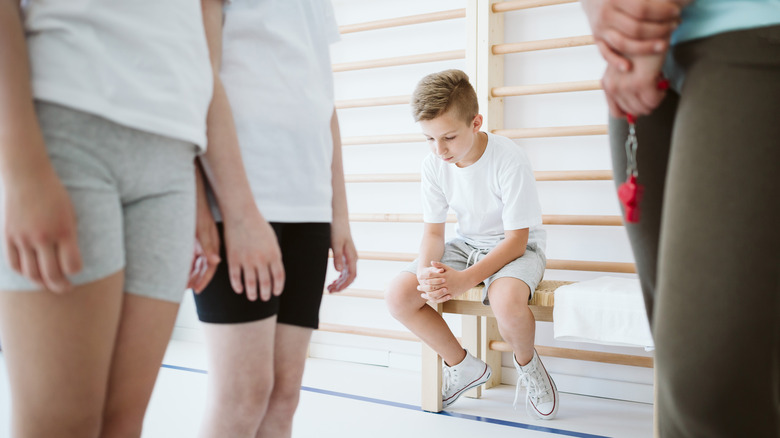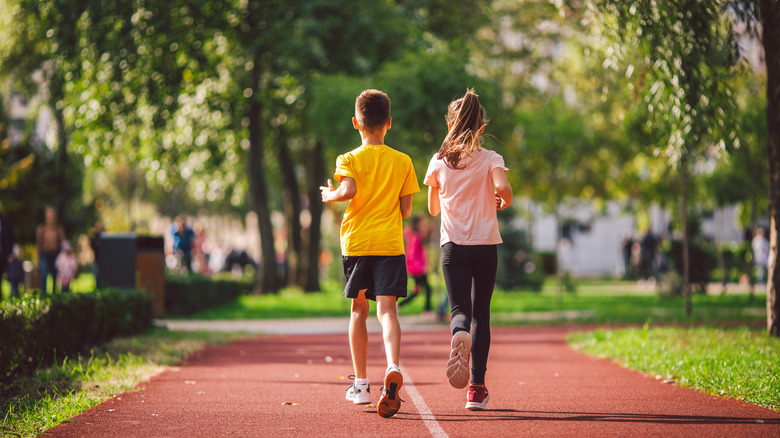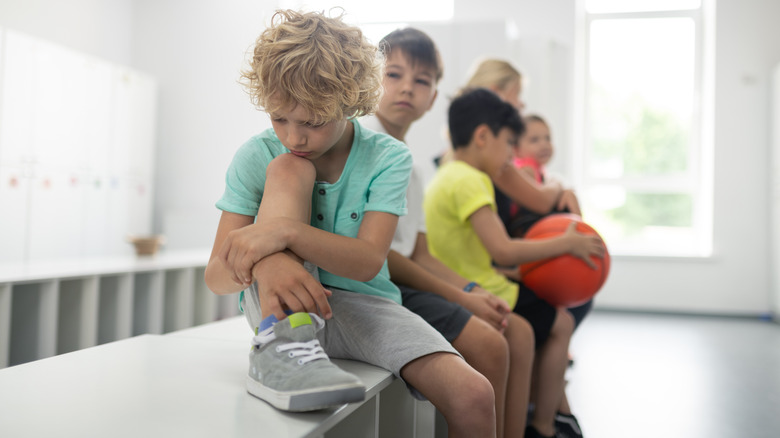Could A Bad Experience In Gym Class As A Kid Affect Us Later In Life?
Does middle school gym class bring back memories you'd wish your brain would permanently erase? Do you dread the thought of lifting weights, doing cardio, or taking a high-intensity interval training (HIIT) class? There may be a correlation between the two, reports The New York Times. While there are many reasons people may be sedentary and avoid the gym, approximately two-thirds of the adult population in the Western world seldom if ever exercise. Those who had negative experiences in childhood gym classes are even more likely to be sedentary.
When it comes to physical education, colloquially known as P.E., a large percentage of adults don't have positive memories of their time in gym class. A 2018 study published in the Translational Journal of the American College of Sports Medicine found that of 1,028 participants interviewed, 203 had embarrassing experiences in school gym class and 107 recalled a lack of enjoyment of the physical education curriculum. 7% of participants even said that their best memories of gym class were either when they were able to skip the class or when the class ended. So if P.E. wasn't your favorite class of the day, you're not alone.
The curriculum may be a root cause
The reason many students dread gym class may be rooted in the Physical Education curricula (via The Atlantic). A 2018 working paper analyzed the Fitness Now initiative in Texas, which mandated daily Physical Education classes, and found that instead of encouraging students to engage in physical fitness, the initiative was followed by a rise in truancy and other disciplinary issues. According to The Atlantic, part of the problem may be in the mandate of 30 minutes of pure physical activity per day under the Fitness Now program, rather than holistic health education including nutrition and unstructured play.
Physical Education curricula have traditionally focused on athletic prowess and turning children into athletes, says The Public Health Advocate. This means that children not interested in sports have largely been overlooked. A lack of resources is a major roadblock to expanding P.E. curricula into holistic health courses. The No Child Left Behind Act has been credited with leaving Physical Education programs with skeleton budgets and fewer resources than needed to provide high-quality programs, since the initiative directed funds into core subjects which didn't include P.E. Across the country, restricted resources disproportionately affect socially vulnerable populations, as lack of physical activity creates deeper health disparities.
Bullying plays a big role
Another reason students skip P.E. and don't find it fun is bullying, for which gym class provides an opportune environment (per The Atlantic). Particularly during middle school years, when peer bullying is at its peak, being in gym class and locker rooms provides a ripe environment for teasing other students about their bodies and physical abilities. The focus of traditional Physical Education curricula on athletic ability offers an opportunity for bullying based on athletic performance, particularly for students who are not athletically inclined and don't perform well on physical tests. Bullying is also credited with an increase in disciplinary incidents during gym classes.
Lack of funding for Physical Education limits the ability to pay staff to oversee P.E. classes (via The Public Health Advocate). Many schools are unable to afford Physical Education instructors, so other staff such as math or science teachers moonlight as P.E. teachers. With staff stretched so thin, the availability of instructors to simultaneously teach lessons, intervene in bullying situations, and provide adult supervision to other students is more wishful thinking than reality.
Finding joy in physical activity
Reform in the Physical Education sphere has focused on making the curricula more enjoyable and holistic (per The Atlantic). This includes teaching kids about nutrition, healthy eating, ways to exercise that aren't just running laps around the school track or doing push-ups, and involving parents in health education. From animated games of tag to school gardens, there are many ways to engage youth in well-rounded physical activity that isn't based on assessing athletic performance (via Verywell Fit). With app, video game, and virtual reality (VR) options for exercising, there are many ways that technology can also get kids moving.
Bad experiences in childhood gym class aren't the only factor contributing to sedentary lifestyles in adulthood. Other reasons adults don't exercise include lack of time, excess stress, and dislike for working out, notes Verywell Fit. But the search for enjoyment in physical activity may very well come down to the type of activity. Not every type of exercise has to be performed in a gym or involve significant exertion. In fact, many forms of physical activity may surprise you. Gardening and yard work, taking your dog for a walk, and household chores like sweeping and wiping counters are all forms of activity that are physical and get your body moving.




